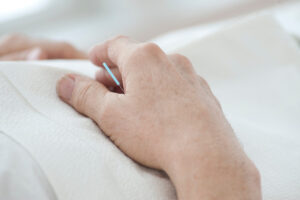 “My friend injured his ankle and is getting dry needling. What is dry needling? Is it different from acupuncture?” a friend asked last week. I told him I would write a blog to address his questions. Here it is:
“My friend injured his ankle and is getting dry needling. What is dry needling? Is it different from acupuncture?” a friend asked last week. I told him I would write a blog to address his questions. Here it is:
Dry needling is the insertion of acupuncture needles into the motor point of a tight muscle to stimulate it to contract and then release. It is performed to treat myofascial pain and dysfunction.
“Dry needling” has become a buzzword since physical therapists in some states, after approximately 46 hours of training, can administer it using sterile one time use FDA approved acupuncture needles. Not all states allow physical therapists to dry needle. In New York State, only acupuncturists with more than 2500 hours of acupuncture training and medical doctors with 300 hours of acupuncture specific training are allowed to dry needle.
That said, I believe dry needling by physical therapists can most definitely help with reducing myofascial pain and tight muscles. In combination with their training in the functional mechanics of the body, it can be exactly what is needed.
Here is the difference: licensed acupuncturists look at pain from a different perspective. We have had 3 years of study and clinical experience that allows us to include ‘dry needling’, or trigger point therapy, as we call it, into our scope of practice.
For example, when I release the trapezius muscles in shoulders that are tight and uncomfortable, I incorporate other needles at strategic points to address the ‘root’ of the problem. Tight muscles are often one of the symptoms of a larger imbalance. I assess what the dysfunction is using Chinese medical diagnosis. I might find what we call “liver qi stagnation” which is quite common, or perhaps “spleen qi deficiency” to name just a couple of possible culprits contributing to pain. If it is the former, in addition to releasing the muscles that are tight or in spasm, I would place needles at specific strategic points on the feet and hands. If the latter, I would place needles at different set of strategic points. In addition, I would also perform tuina (Chinese massage) on the back and perhaps gua sha.
One advantage of acupuncture is the sense of relaxation and well-being a treatment affords. A course of treatment can help with related and myriad symptoms which might include irritability, depression, and even craving for sweets.
I hope this at least begins to give my friend and readers a preliminary explanation of what dry needling is and how it pertains to acupuncture.
If you would like to schedule an appointment, contact me at maureen@maureengossacupuncture.com.







Leave a Reply